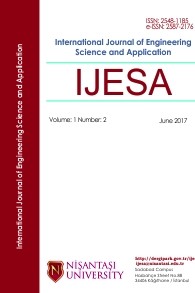Broadband Power Amplifier for Cellular Base Station Application
Broadband Power Amplifier for Cellular Base Station Application
The growing demand for higher data rates and a broader bandwidth in modern cellular communication systems continues to push researchers to build a new system that can meet the communication requirements and contributes significantly to the field of high efficiency and wideband power amplifiers. The base-station transceivers require power amplifiers with increasingly high efficiency, low operational cost and wider bandwidth. The challenges of meeting all these requirements simultaneously motivated the design, simulation and evaluation of a Power Amplifier (PA) for base-station application. Advanced Design System (ADS) software was used to simulate broadband PA based on the ATF13786 Gallium Arsenide (GaAs) transistor, across the 850 MHz to 3GHz frequency range. The simulated small and large signal results of the PA revealed a saturated output power of 25.19dBm with a 1-dB compression point at 26.425 dBm output power level, a Power Added Efficiency (PAE) of 32.41 percent and maximum gain of 9.5 dB. The input return loss S11 and output return loss S22 are both less than 10 dB over the whole functioning frequency ranges. The minimal values of the computed and simulated Rollett and Bodway stability factors were 1.1751 and 0.092, respectively. However, the simulated PA is unconditionally stable within a fraction of the proposed frequency band; that is 850MHz 1.7GHz. Given the wide frequency range, the simulated results show that the input and output matching networks perform well over the operating frequency range. The results of simulated BPA compared favorably with those of available designs and their results meet the operational requirements
Keywords:
Broadbnd Power Ampifier (BPA) Gallium Arsenide Transistor GaAs, Advanced Design System (ADS), Power ampifier (PA),
___
- References [1] C. P. Huang, “A Multimode 5–6 GHz SiGe BiCMOS PA Design Powers Emerging Wireless LAN Radio Standards, in 2017”, IEEE Bipolar/BiCMOS Circuits and Technology Meeting (BCTM), pp. 38-41, 2017.
- [2] S. R. Balanethiram, A. D’Esposito, S. Chakravorty, Fregonese, and T. Zimmer, “Extraction of BEOL Contributions for Thermal Resistance in SiGe HBTs”, IEEE Transactions on Electron Devices, vol. 64, no. 3, pp. 1380-1384, 2017
- [3] Simbase, Electronics Tutorials/Amplifier/Frequency Response, https:// www. Electronic tutorial, 4 June 2019 Revol No. 07.
- [4] A. Rachakh, L. El Abdellaoui, J. Zbitou, A. Errkik, A. Tajouati, and M. Latrach. “A Novel Configuration of a Microstrip Microwave Wideband Power Amplifier for Wireless Application”, Telkomnika, Vol.16, No.1, pp.2014-2031, 2018
- [5] N. Rostomyan, M. Ozen, P. Asbeck, “28 GHz Doherty Power Amplifier in CMOS SOIWith 28% Back-Off PAE”. IEEE Microw., Wirel. Compon. Lett. 28, 446–448, 2018.
- [6] M. M. Tarar and R. Negra, “Design and Implementation of Wideband Stacked Distributed Power Amplifier in 0.13-μm CMOS Using Uniform Distributed Topology”, IEEE Transactions on Microwave Theory and Techniques, vol. 65, no. 12, pp. 5212-5222, 2017.
- [7] M. Iqbal, “Advanced High Efficiency and Broadband Power Amplifiers Based on GaN HEMT for Wireless Applications”. PhD thesis, 2017.
- [8] J.E. Pen, “1.2- and 2.4-mm Gallium Nitride (GaN) Power Amplifier Designs. Sensors and Electron Devices Directorate”, ARL 1215 Jefferson Davis Highway, Suite 1204, Arlington, VA 22202-4302 2016.
- [9] S. C. Cripps, “RF Power Amplifiers for Wireless Communications”, 2nd ed. Norwood, MA: Artech House, 2006.
- [10] D. Gustafsson, C. M. Andersson, and C. A. Fager, “Modified Doherty power amplifier with extended bandwidth and reconfigurable efficiency”. IEEE transactions on microwave theory and techniques, 61(1), 533-542, 2019.
- [11] M. M. Tarar and R. Negra, “Design and Implementation of Wideband Stacked Distributed Power Amplifier in 0.13-μm CMOS Using Uniform Distributed Topology”, IEEE Tra nsactions on Microwave Theory and Techniques, vol. 65, no. 12, pp. 5212-5222, 2018.
- [12] N. Giovannelli, “A 250W LDMOS Doherty PA with 31% of Fractional Bandwidth for DVB-T Applications”, IEEE MTT-S Int. Microw. Symp., Tampa Bay, FL, USA, pp. 1– 4, june 2014.
- [13] K. Li, T. Shi, S. Di and W. Yin, "A 40W ultra broadband LDMOS power amplifier," 2015 IEEE MTT-S International Microwave Symposium, Phoenix, AZ, USA, 2015, pp. 1-4, doi: 10.1109/MWSYM.2015.7166842. [14] Chun-Q, M. Chen, Z. Hao, Z. Li, and Y. Hao, “A 1.8–2.8GHz Highly Linear Broadband Power Amplifier for LTE-A Application”, Progress. In Electromagnetics Research C, Vol. 66, 47–54, 2016
- [15] N. Tuffy, A. Zhu, and T.J. Brazil, “Novel Realisation of a Broadband High-Efficiency Continuous Class-F Power Amplifier”, European Microw. Integr. Circuits Conf., Manchester, UK, pp. 120–123, October 2011. [16] M. Golio, “RF and Microwave Semiconductor Device Handbook”, CRC Press, Boca, USA, ISBN: 978-08493-1562-6, pp. 340, 01/February/2003
- [17] Keysight Technologies, S-parameters Measurements, Basics for High speed Digital Engineers published in USA. June 2019, 5991 – 3736EN: http: www.keysight.com.
- [18] L. Wu, “Design of Radio Frequency Power Amplifiers for Cellular Phones and Base”, IEEE Microwave and Wireless Components Letters, Vol.28, No.1, pp.37-39, 2009.
- [19] S. A. Mohadeskasaei, “A Systematic Approach for Design of Broadband, High Efficiency, High Power RF Amplifiers”, ETRI Journal, Volume 39, Number 101, https://doi.org/10.4218/etrij.17.0116.0440, February 2018
- [20] J. Inchan, “A Study on Design Methodologies of Power Amplifiers using SIGE HBT BICMOS Technologies”, A Dissertation School of Electrical and Computer Engineering. Georgia Institute of Technology, 2019.
- [21] B. Francois, and P. Reynaert, “Highly linear fully integrated wideband RF PA for LTE-advanced in 180-nm SOI”, IEEE Transactions on Microwave Theory and Techniques, Vol. 63, No.3, pp. 649–658, 2015.
- ISSN: 2548-1185
- Başlangıç: 2016
- Yayıncı: Nişantaşı Üniversitesi
Sayıdaki Diğer Makaleler
NUMERICAL INVESTIGATION OF THE MIXING MECHANISM OF PASSIVE MICROMIXER WITH TESLA STRUCTURE
Esra AĞEL, Batı ALTINDAĞ, Osman ERGİN, Zeynep KUNT, Ali Bahadır OLCAY
Properties of Recycled Aggregates and Their Effects on Concrete
Hossein ZORİYEH ALİGHOLİ, Ahmet Kaan YILDIRIM
Broadband Power Amplifier for Cellular Base Station Application
Sanusi ABDULLAHİ AHMED, Florence IKECHİAMAKA, Akinbolati AKİNSANMİ
Geometrically and Electrically Optimized Electromagnetic Micro Power Generator
Mohammad Bagher BANNAE SHARİFİAN, Manouchehr BAHRAMI, Mohammad Reza BALAZADEH BAHAR
